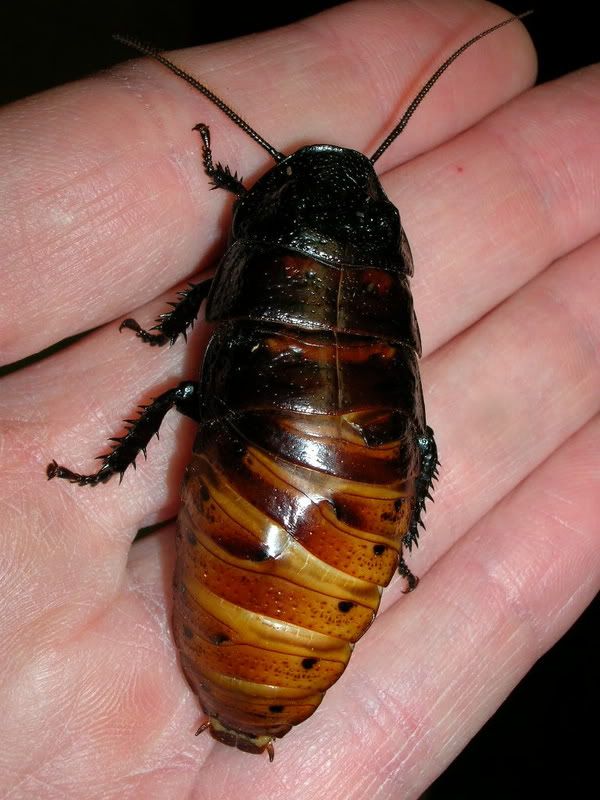Hisserdude
Arachnoking
- Joined
- Apr 18, 2015
- Messages
- 2,460
It's easier to keep track of their growth if I name them, and instead of saying "oh look, number 6 molted", I can say "oh look, Hopper molted". Plus they're gonna be around a while, so why not name them, lol!You Named Them???
LOL / JK
They're Looking Fat & Happy
Best Of Luck With You Breeding Project
I know right? I would love to have some vinegaroons, they look so interesting! And I'm surprised more people don't keep JCs, they are found in many states, so lots of people can just catch them themselves, and they are a blast to keep!Two inverts in the hobby I don't understand not being so popular, Jerusalem cricket and vinegaroons.
Yeah, she's pretty! It sure would be cool, if I'm successful in breeding them we will see.Those are very peculiar markings on swirl. I wonder if those are heritable. It'd be cool to have a Stenopelmatus sp. "swirl" culture.
Whenever they start breeding let me know. I'd be down to have a little swirl jr lolYeah, she's pretty! It sure would be cool, if I'm successful in breeding them we will see.
Ok, if they successfully breed I'll keep you in mind!Whenever they start breeding let me know. I'd be down to have a little swirl jr lol
She has molted many times, the deformation remains. It often happens to roaches and millipedes, I think it is permanent, probably genetic.Do you think swirl may have just had a weird molt? Like what happens with roaches and millipedes.
Well it looks like the actual abdominal segments 3 and 5 are deformed. No amount of molting would fix that. It's probably a genetic mutation of some sort but it could also just be an issue in differentiating when it developed. I'm honestly interested to know if she's fertile or not. Since the abdomen is where most of the vegetative work happens (the thorax is mostly nerve and muscle) it could possibly affect her below the skin. I guess only time will tell when she mates.Do you think swirl may have just had a weird molt? Like what happens with roaches and millipedes.
Actually two of my eight have this deformity, it seems pretty common in Jerusalem crickets. I'm sure she'll be fertile, similar segment deformation occurs in some millipedes and cockroaches, and does not seem to affect overall health nor fertility.Well it looks like the actual abdominal segments 3 and 5 are deformed. No amount of molting would fix that. It's probably a genetic mutation of some sort but it could also just be an issue in differentiating when it developed. I'm honestly interested to know if she's fertile or not. Since the abdomen is where most of the vegetative work happens (the thorax is mostly nerve and muscle) it could possibly affect her below the skin. I guess only time will tell when she mates.
Also, may I suggest you keep her body when she passes? An abberation like that is unusual and rare to come by. People at some institutions would probably love to look at her.
Huh. That's actually pretty interesting. I wonder if their young will have a higher chance of getting it. Do you have any pictures of the millipedes or roaches with it? I haven't seen it before and I've had a roach colony for years so I am very intrigued.Actually two of my eight have this deformity, it seems pretty common in Jerusalem crickets. I'm sure she'll be fertile, similar segment deformation occurs in some millipedes and cockroaches, and does not seem to affect overall health nor fertility.
I could try to preserve the body, but like I said this seems to be a common deformity in JCs and they don't preserve well.
Orin McMonigle has pictures of millipedes with this type of deformation in his book "Millipedes in Captivity", and I believe I saw pictures of Gromphadorhina sp roaches with deformations similar to this on the internet somewhere, I'll try to find them.Huh. That's actually pretty interesting. I wonder if their young will have a higher chance of getting it. Do you have any pictures of the millipedes or roaches with it? I haven't seen it before and I've had a roach colony for years so I am very intrigued.
And sorry about that haha, my focus is mainly on hymenoptera so I don't know too much about crickets.
Maybe just pin it and see how it dries. What's the worst that could happen?
